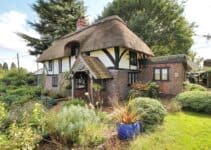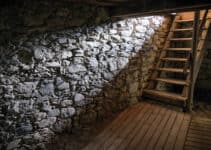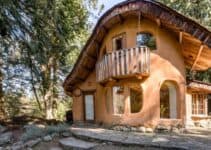These days, everyone seems to be fascinated with old English cottages. People love them regardless of what colour they are painted or what material is used.
And the reason why is that these cottages have a rustic, vintage vibe and a lovely, fairytale-like appearance that we feel and connect with.
They also tend to be snug, cosy places with a sense of being a real home to someone.
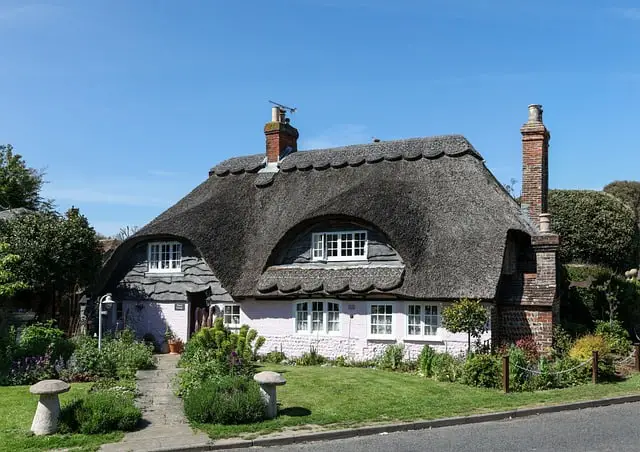
How Were Old English Cottages Built?
Old English cottages trace back to the Tudor and Stuart times in England’s history when the country was prospering, entering the Golden Age under Good Queen Bess.
Never had the country had it so good, and new houses popped up all over the country, with amazing craftsmanship going into the buildings, particularly carpentry.
Most old English cottages were built around this time, particularly the half-timbered ones.
The cottage building boom ended in the mid-seventeenth century. During the 18th and 19th centuries, Queen Anne and Georgian-style architecture replaced what was seen then as the humble cottage.
The traditional English cottage dates back to a time of great affluence and of skilled craftsmanship by artisans. The houses were born in far simpler times before the Industrial Revolution came along and changed everything for the country, including the ways houses were constructed.
What is an English Cottage Called?
A traditional English cottage is called a Squatter’s Cottage.
Back in the 1600 and 1700s, English common law ruled that if a house could be constructed within 24 hours, with smoke seen rising from its chimney at the end of the construction day, then the ‘squatter’ who built that cottage could claim the land as their own.
This gave rise to what became known as a Squatter’s Cottage. It was typically one room upstairs and downstairs and then was later extended upon to become much bigger.
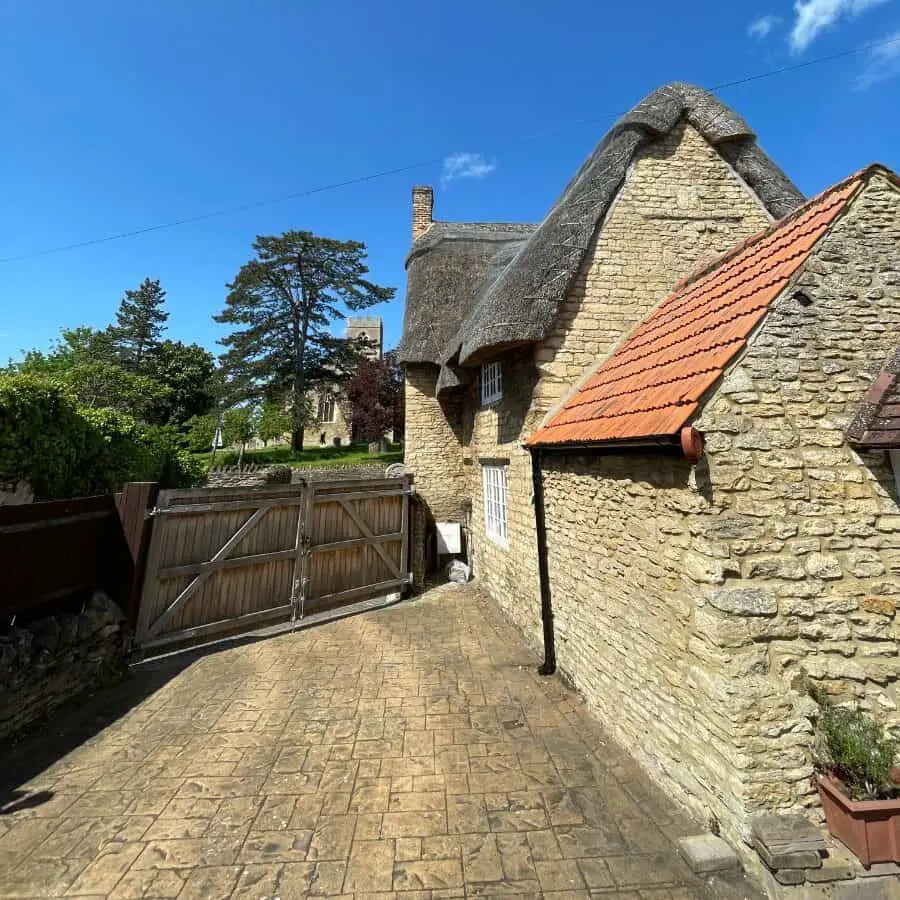
What Are English Cottages Made Of?
Old English cottages were built with any of the materials found in the local environment. The cottage constructor made do with what he had and learned the indigenous style of construction to his area.
The majority of old cottages are built using locally sourced materials. Because they are built from the environment, they blend with the environment: traditional English cottages match the local environment so well as they are built out of the local environment, quite literally.
Builders used materials they could find locally and became skilled with knowing how to build with the specific materials local to their area.
Cottages were built out of stone, granite, or cob cottages would be built from straw and mud if nothing else was available. The latter are remarkably resilient buildings.
The wood from the local trees were used (often English oak) for the cruck-frames and the house’s timber-frames. The half-timbered style house mainly dates to between 1550 and 1650, the golden age of traditional English cottage building.
Most of the windows were mullion or casement, and the roofs were usually thatched. They were often made using post and beam construction, resulting in low ceilings, exposed wood beams, and a mud ground. You’d usually also find sinks in the bedrooms. The floors were eventually replaced by tiles put in a sand layer.
In the West Country, roofs were originally thatched and later tiled or shingled with blue slate from the mines. Because of this, old cottages blend seamlessly into the landscape.
In England, thatch is made of lengthy straw harvested expressly for this purpose, and multiple layers of straw are stacked on top of each other.
Other materials used include water reed and combed wheat reed, again whatever was most local to the area.
:max_bytes(150000):strip_icc()/TudorMyWealdDownland-80743623634d4bb9b34bcc3f8a0dc3a7.jpg)
Different Types of Old English Cottages
Cottages are available in a variety of forms, sizes, and designs. While they all have a special vibe and a feeling to them, you may find yourself going toward and choosing a specific aesthetic and style over and over again.
There are 6 different types of cottages you may recognise:
English Thatched Cottages
The thatched cottage is quintessentially English. Cottages made of this old type of straw roofing, are now greatly in demand by house buyers.
Because thatched roofs are so attractive, several new buildings are being constructed using them now, which is ironic given that thatching was traditionally associated with poverty.
Thatched cottages are a cost-effective and eco-friendly approach to insulate the home without having to pay for a real roof.
These houses are now a distinguishing feature of the English countryside and communities.
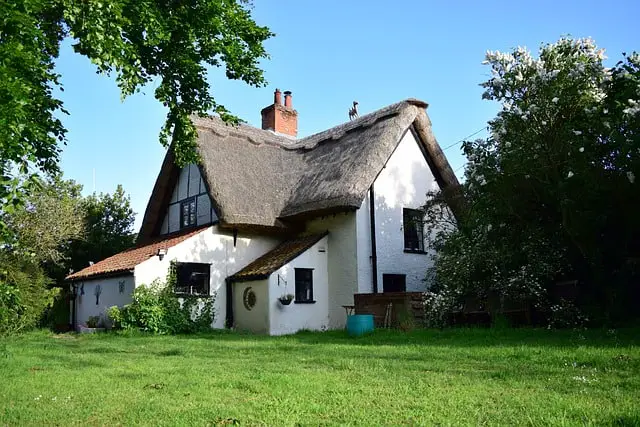
Yorkshire Dales Cottages
The Yorkshire Dales, or The Dales, are located in Yorkshire’s northern county. They are valleys and rivers with some of Europe’s most stunningly beautiful landscapes.
Upper Wharfedale, Malham, and the villages of Wensleydale are great examples where these unique cottages can be found.
Cotswolds Cottages
The Cotswold Hills has many beautiful thatched cottages, but it is also well known for the beautiful landscape made from the region’s characteristic honey-colored stone.
The Cotswolds are not like any other English area because of this stone, which gives the cottages there a warm ambiance.
Burford, Bibury, and Castle Combe are often considered to be the best examples of these special cottages.
Vicarages, Parsonages & Rectories Cottages
You can find a church in most villages in England, and nearby it would be a house for the vicar, rector, or parson.
Numerous of them are beautiful houses that have been underused since the church has shrunk (or even closed) and many parishes have been merged, with a lot of these houses having been auctioned off by the church.
These are currently incredibly desirable locations to live, typically serving as the village’s most magnificent cottages in the heart of the village.
Half Timbered Cottages
Timbered reinforced homes with exposed structural frames on the outside walls are known as half-timbered cottages. On a white background, they are usually dark in colour and form a beautiful pattern.
They are especially common in the West Midlands.
Fishermen Cottages
The houses where fishermen resided are a significant feature of several coastal towns and villages, particularly in the West Country.
Numerous of them are white, but sometimes they are painted in bright colours, and they make a wonderful sight now for today’s tourists who frequent these locations.
These cottages were terraced buildings built in lines leading down to the harbour since they were built in small towns and villages where space was at a premium.
A great example of these cottages may be found in Devon and Cornwall in places like Looe and Polperro.
Old English House
The old English house experienced its glorious period with England, after which it was left to age like a fine wine, and it grows with elegance and beauty that is unmatched by any modern structure.
The narrative of the cottage might end here, but fortunately, it does not.
It is because of all the homeowners that carefully seek to restore and repair historic houses to their former glory form that we can still enjoy many up to this day.
